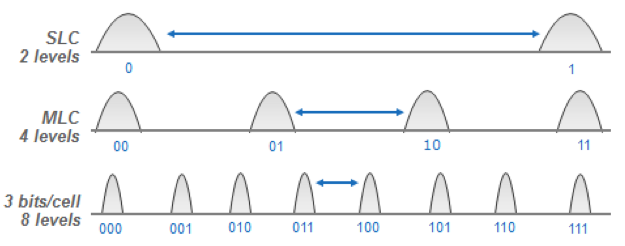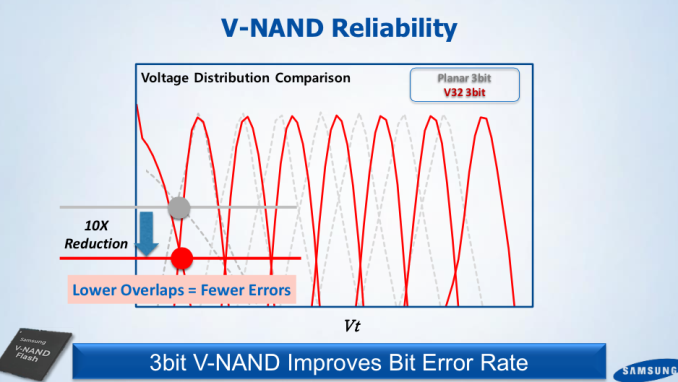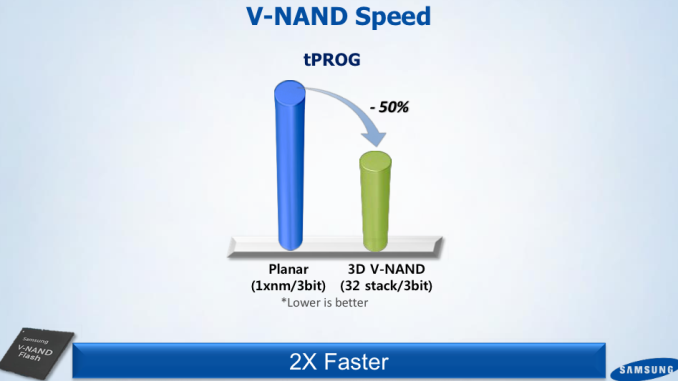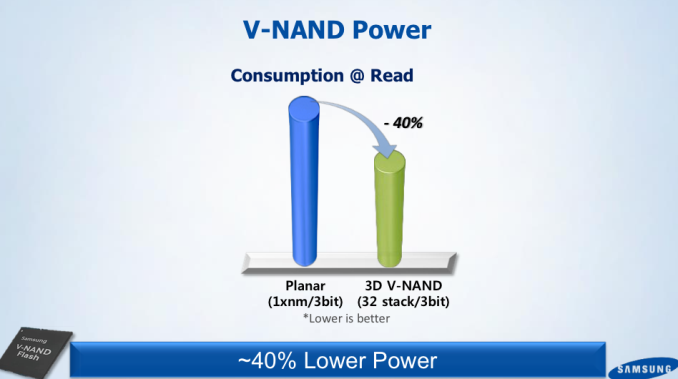Samsung SSD 850 EVO (120GB, 250GB, 500GB & 1TB) Review
by Kristian Vättö on December 8, 2014 10:00 AM ESTThree Bits and Three Dimensions: What's the Deal?
I've covered 3D NAND and TLC NAND in detail in the past and in this article I'll just explain what 3D technology means to TLC NAND and vice versa, so head over to the links above if you are in the search for a deeper analysis of the two technologies.
Truth to be told, 3D technology is ideal for TLC. The fundamental problem of TLC NAND has always been the limited endurance and performance, which is caused by the additional voltage states that are needed to store three bits (i.e. eight possible bit outputs) in one cell. With eight voltage states compared to four in MLC, TLC NAND is less resistant to wear out because it takes a smaller change in the cell charge to corrupt the cell value. Due to the way NAND works, the cells (or the insulators in the cell to be exact) wear out over time, which induces electron leakage that alters the cell charge and hence the voltage state. This gets worse with die shrinks because the number of electrons decreases, making the NAND even less tolerant to wear out.
The key aspect of 3D V-NAND is the process node. By going back to 40nm lithography, the number of electrons increase exponentially, which makes TLC a much more viable technology than it was with modern planar NAND. Obviously, V-NAND doesn't change the basics of TLC NAND because it still takes eight voltage states to differentiate all the possible 3-bit outputs, but thanks to the increased number of electrons there is more breathing room between the states and thus the cells are more error tolerant.
Samsung claims 10x reduction in voltage state overlaps, which is a massive change for the better. You can see how crammed the planar TLC voltage states are, so it's no wonder that the endurance is low because the states are practically overlapping at each point in the voltage distribution and hence even tiny changes in the cell voltage can alter the cell's voltage state.
The larger cell structure also enables higher performance because it takes less iterations to program a cell. With planar TLC NAND it took multiple very high voltage pulses as well as numerous verification process to reach the right charge, but with looser voltage distribution the programming process has less steps and thus takes less time.
And given the lower read/program latencies and less need for error correction, the power consumption is also considerably lower.
In addition to better latency and power consumption characteristics, Samsung claims doubled the density over its 19nm planar TLC NAND, but without knowing the die size of 128Gbit 32-layer TLC V-NAND, it's hard to say how accurate this is. There have been some whispering that the 128Gbit die would actually be identical to the 86Gbit MLC die because 86Gbit multiplied by 1.5 equals 129Gbit and at the silicon level MLC and TLC aren't any different, but for now that's just speculation.
What I do know is that Samsung started the mass production of TLC V-NAND later, which suggests that the two aren't completely uniform. Moreover, from what I know TLC NAND requires some changes to the peripheral circuitry in order to read three bits from one cell, so while the NAND memory arrays could be alike the die size is still likely at least slightly different. Anyway, we'll find out when Chipworks (or some other silicon analysis company) takes a closer look at the NAND die itself.















97 Comments
View All Comments
hojnikb - Monday, December 8, 2014 - link
Or 50$ less and get a mx100/ultra IIapoe - Tuesday, December 9, 2014 - link
$10 more than the 250GB 850 Evo and you can get a 480GB Crucial M500 or TWO Sandisk Ultra II's. Even though it's a year and a half old at this point, for most end users the speed difference is negligible but the doubled capacity is not. Like the article says, the pricing (at least the MSRP) seems to be in a weird place...HisDivineOrder - Wednesday, December 10, 2014 - link
Samsung thinks they're Apple.In SSD's.
alacard - Monday, December 8, 2014 - link
thanks for the review. is it my imagination or is the 120gb model missing from the destroyer benchmark?Kristian Vättö - Tuesday, December 9, 2014 - link
I don't usually run the 2013 suite on 120/128GB drives because it's more geared towards large and higher performance drives. Users with such heavy workloads shouldn't be buying small drives anyway for performance and capacity reasons.Memristor - Monday, December 8, 2014 - link
Regarding the price, newegg.com already offers them below the suggested retail price. See here:http://promotions.newegg.com/samsung/14-6480/index...
wallysb01 - Monday, December 8, 2014 - link
Only by $10. That’s not really enough. I got the 480 GB Ultra II for $160 over black Friday, that’s $90 less than this sale on the 500GB 850 EVO. That was maybe an atypically good deal, but even at more regular discounts the Ultra II/MX100 is priced at about $180-$190, maybe $200, which is more like $50-$70 less than this “sale” price 850 EVO.This review is right. Until the price comes down ~$50 per 500GB, I don’t see much reason for people buy the 850 EVO.
fokka - Monday, December 8, 2014 - link
comparing msrp to a black friday deal doesn't make sense.Luscious - Monday, December 8, 2014 - link
Where's the m.2 version?And if Samsung is stubbornly sticking with 2.5 inch drives, why no Sata Express version?
The hardware for both is out there, and has been for some time.
ZeDestructor - Monday, December 8, 2014 - link
It's a SATA drive, so the interface will be SATA and not SATA Express/PCIe. Consequently, an M.2 variant will perform the same, since those variants would also be SATA driven, much like the older mSATA drives - same thing, different form factor, and unnecessary to review seperately.